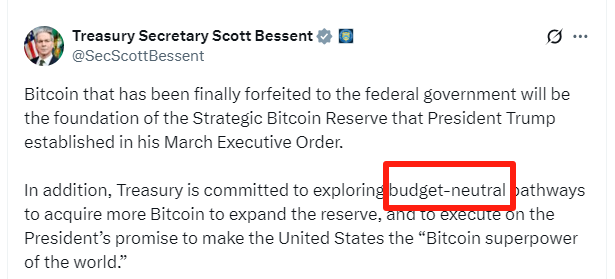How Is the U.S. Accumulating Bitcoin — and Why Is the Market Watching So Closely?
Introduction
TradingKey – On August 15, U.S. Treasury Secretary Scott Bessent stated that the government would not directly purchase additional Bitcoin, but later clarified that the strategic reserve expansion plan remains active. Despite the clarification, Bitcoin dropped more than 4% that day.
As the anchor of the global financial system, the U.S.'s approach to Bitcoin reserves — whether it chooses to accumulate and how — has become one of the most closely watched issues in the crypto market. This decision could not only influence Bitcoin’s valuation but also reshape the global monetary order.
Trump’s Budget-Neutral Bitcoin Reserve Strategy
On March 2, 2025, President Donald Trump announced the inclusion of five cryptocurrencies in the Strategic Crypto Reserve:
- Bitcoin (BTC)
- Ethereum (ETH)
- Ripple (XRP)
- Solana (SOL)
- Cardano (ADA)
On March 7, Trump signed an executive order directing the transfer of approximately 200,000 BTC — previously seized through criminal and civil actions — into the reserve. He also tasked the Commerce and Treasury Departments with exploring budget-neutral methods to expand the reserve. White House “Crypto Czar” David Sacks praised the move, saying it wouldn’t cost taxpayers “a single penny.”
On August 15, Bessent reiterated the commitment to budget-neutral accumulation, stating: “Treasury is committed to exploring budget-neutral pathways to acquire more Bitcoin and fulfill the President’s promise to make the U.S. the Bitcoin superpower of the world.” However, no formal budget-neutral strategy has been implemented to date.

Tweet posted by Bessant, source: X
What Are the U.S.’s Reserve Options?
Currently, the only active strategy is confiscation-based accumulation. But several budget-neutral proposals have been floated, including:
- Accepting donations
- Using tariff revenue
- Selling gold (XAUUSD) or oil (USOIL) reserves to buy BTC
Author Adam Livingston suggested allocating a portion of monthly trade surplus to Bitcoin purchases. The Federal Reserve has also explored using valuation gains from gold reserves to fund BTC accumulation.
Still, no official response has been given. Critics like Arthur Hayes, co-founder of BitMEX, have dismissed the reserve plan as “just talk,” calling it a political stunt with no real execution.
Why Does the Market Care So Much?
The U.S. Bitcoin reserve strategy is more than asset allocation — it’s a policy signal. The method of accumulation reflects the level of institutional legitimacy granted to Bitcoin. Broadly, strategies fall into two categories:
Strategy Type | Purchase-Based | Non-Purchase-Based |
Method | Treasury revenue, tariffs, gold/oil sales | Donations, seizures, mining, crypto tax |
Signal Strength | Strongest possible endorsement | Moderate recognition |
Dollar Strategy | Assertive defense of dollar dominance in digital space | Passive stance, leaves room for rivals like China or Korea |
Market Impact | Removes BTC from circulation, tightens supply, drives price structurally higher | Minimal impact on liquidity, soft influence on price |
Market Interpretation | Bitcoin elevated to sovereign-grade reserve asset | Bitcoin seen as a promising investment, not a monetary pillar |
Global Effect | Forces central banks and sovereign funds to reallocate, triggers global “Bitcoin race” | Encourages institutional adoption, but no sovereign urgency |
Conclusion
In short, the form of U.S. Bitcoin accumulation is a powerful policy language. A direct purchase strategy could trigger a seismic shift in global finance, while a passive approach would reinforce the status quo. For investors, understanding how the U.S. acts is more important than whether it acts at all.



